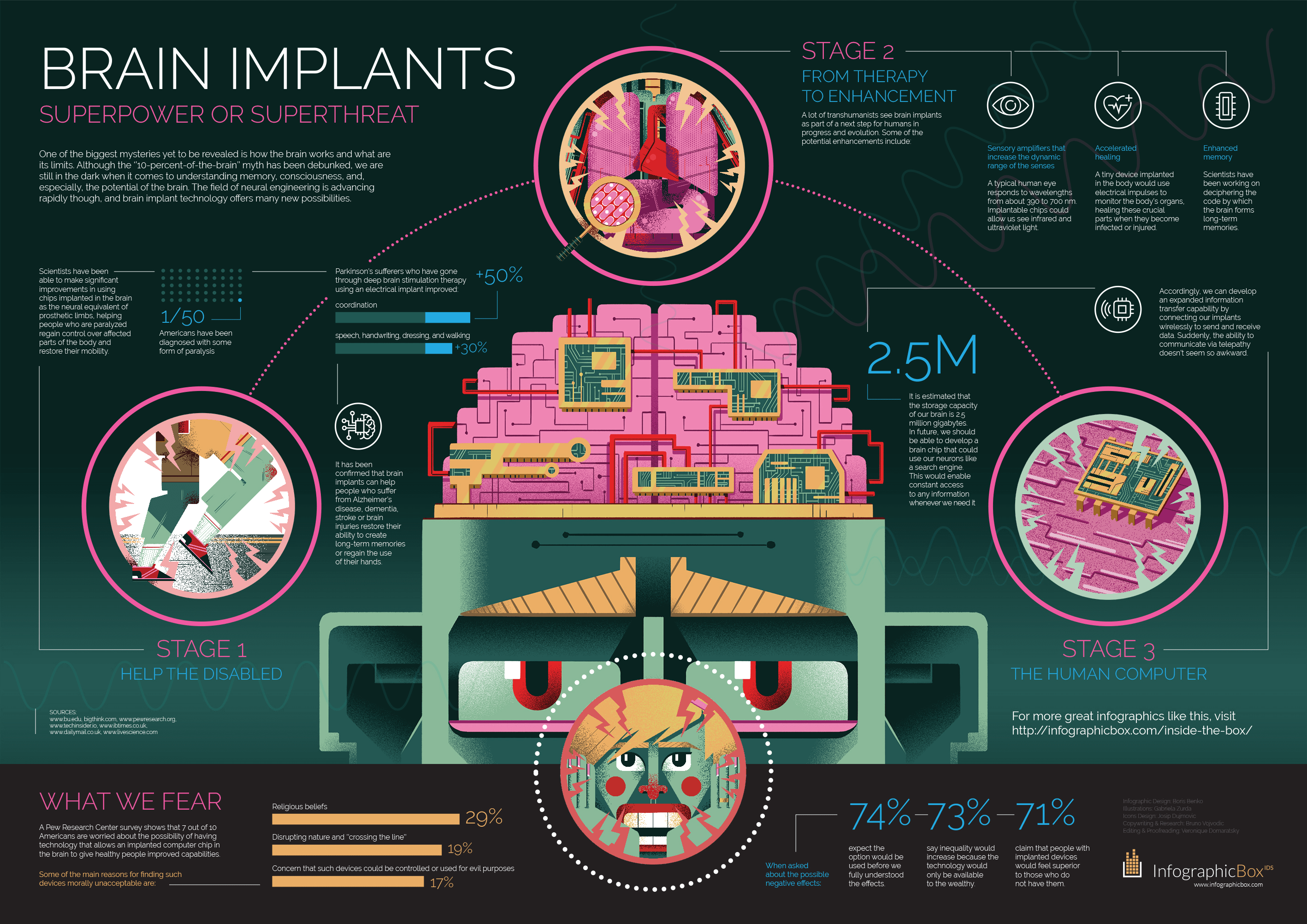(Article update: 02-19-2025)
Scientists have been researching and developing brain implants that could connect the human brain to other devices, allowing humans to control technology with their minds. In 2025, this technology is expected to advance significantly, moving beyond medical applications to revolutionize fields like education, mental health, and augmented reality. While brain implants have already shown promise in helping patients with conditions like paralysis and dementia, the next few years could see them enhancing cognitive abilities, regulating emotions, and integrating seamlessly with AR environments. However, as the technology evolves, ethical, societal, and environmental considerations will play a crucial role in shaping its future.
The human brain is a mystery and there’s still a lot to discover on how this organ works, but it’s proven that brain implants are helpful to people that suffer from dementia, Alzheimer’s, stroke, or brain injuries.

(Infographic source: infographicbox.com)
Currently, the benefits of this technology are being seen in the medical field, especially with paralyzed people that can now type with their minds after the brain implants, like Dennis Degray, paralyzed from his collarbones down after a fall over ten years ago. In 2016 Dennis had two tiny metal electrodes surgically implanted on the part of his brain that controls movements and sent a text message to his friend directly from the neurons.
Researchers also discovered the benefits of brain implants on possible vision problems after they provided an artificial vision to monkeys, so this could become a step closer to restoring vision to blind people.
But if this technology leaves the medical field, the military will also use it in order to provide completely silent communication between soldiers and the possibility of activating equipment by thinking of commands.
Companies Developing the Brain Implements Technology
The brain implant made for Dennis Degray was the one developed by Utah. They proved that making brain implants is a reality, but there’s still a lot of developments to be made. The Utah implants require open brain surgery and the system needs to be wired to computers in order to decode the signal by machine-learning algorithms. It’s possible, but it’s a very limited system since it only records from a number of neurons.
The Utah implants are also unlikely to last forever as the brain’s scar tissue grows up on the electrodes, in order to repair the damage done by the implants, causing a decline in the signal quality.
In 2025, the field of brain-computer interfaces (BCIs) is seeing significant advancements, with several companies pushing the boundaries of neural technology. Among the key players, Paradromics and Synchron are making notable strides, each with unique approaches to brain implants.
Paradromics is focusing on developing compact, high-density electrode arrays that can be implanted without the need for complex robotic surgery. Their goal is to create a minimally invasive system capable of capturing and interpreting neural signals with precision. Meanwhile, Synchron has taken a different route by designing a device that avoids open-brain surgery altogether. Their implant is inserted through a vein in the neck, offering a less invasive alternative for patients.
While Neuralink, has drawn significant attention with its coin-sized implant and ultra-thin wires, the broader landscape of brain-computer interfaces is becoming increasingly competitive. These emerging technologies aim to revolutionize medical treatments, offering potential solutions for neurological disorders and paving the way for deeper integration between humans and machines. The race to develop safe, effective, and accessible brain implants is heating up, with multiple innovators contributing to this transformative field
All the companies are working on developing this technology with medical applications in mind, but all of them have in mind that this can be later applied in the general population as they believe that people will see how innovative and transformational it can be.
The General Population Opinion on the Use of Brain Implants
As the companies believe that people outside the medical applications will want to use the brain implants technology the Pew Research Center made a survey to understand what is the public opinion regarding this subject. As brain implants are being used in hundreds of thousands of people with brain injuries and diseases the research center wanted to know, in a hypothetical scenario, what people think about the possibility of implementing a computer chip in the brain in order to process information, control devices and improve the ability to focus.

The results of the survey showed that Americans are more concerned about brain implants. Only 9% say that they are very enthusiastic about it, 25% are somewhat enthusiastic about the prospect, and 64% are not at all enthusiastic about the potential technology.
Also, 74% of Americans expect that brain implants will have more negative effects than positive ones. Also, 73% believe that the technology will increase inequality as the device will only be available for the wealthy.
The public is not looking too forward to using brain implants outside the medical field. The general impression is that the technology is going too far and won’t be helpful — something that the companies will have to work on in order to change people’s minds.
By Gary Bernstein









